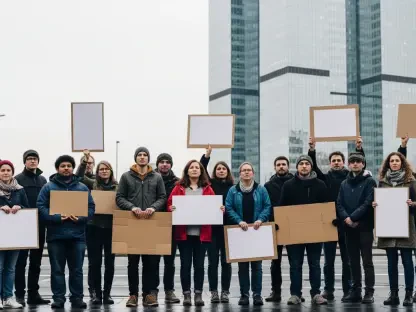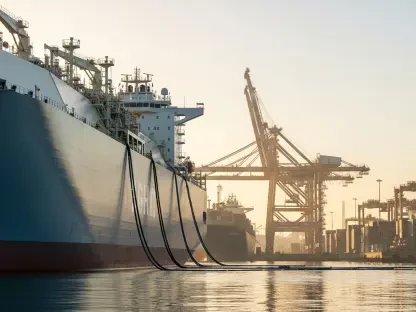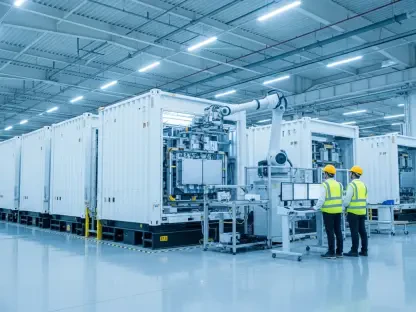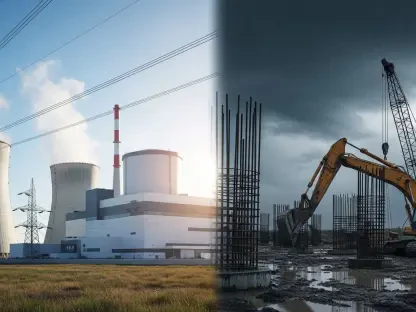The European Commission’s Scale-up Initiative, launched in collaboration with the European Investment Bank (EIB), aims to significantly boost investments in energy efficiency across the European Union (EU). This strategic project addresses the urgent need for decarbonization by mobilizing both public and private funds to support energy efficiency projects. Examining Poland as a case study, the initiative highlights how financial instruments can facilitate sustainable energy transitions and identifies the main challenges and prerequisites for scaling up energy efficiency across EU member states. The integration of financial instruments into energy investments showcases a multifaceted approach to tackling environmental, economic, and geopolitical challenges.
The Urgency Behind the Scale-up Initiative
The pressing need for the Scale-up Initiative is driven by environmental imperatives and geopolitical shifts, particularly intensified by Russia’s aggression in Ukraine. This conflict has upended traditional energy supply chains, prompting the EU to reduce its dependency on Russian energy production, leading to increased energy prices and supply insecurity. In this context, the EU’s commitment to energy efficiency becomes not just an environmental necessity but also a geopolitical strategy to ensure energy security and stability. By focusing on improving insulation in buildings, the initiative aims to reduce energy demand, thereby lowering greenhouse gas emissions and mitigating the effects of climate change.
Efficiently insulated homes and offices play a crucial role in this strategy, as they can drastically decrease the amount of energy required for heating and cooling. This reduction in energy consumption translates into lower greenhouse gas emissions, which in turn helps prevent extreme weather events and reduces their social and economic impacts. Moreover, investments in energy efficiency have the potential to strengthen European economies by decreasing the reliance on energy imports, thereby enhancing economic resilience. Lower energy bills free up resources for businesses to invest in productivity and innovation, creating a win-win situation that boosts competitiveness and fosters sustainable economic growth.
Financial Challenges Highlighted by Poland’s Case
The costs associated with the energy transition are substantial, and public funds alone are insufficient to meet these financial demands. Poland, one of the largest beneficiaries of EU cohesion policy, faces climate and energy transition costs estimated at around €550 billion from 2021 to 2040. In stark contrast, the European Regional Development Fund (ERDF) allocation to Poland stands at €47 billion, highlighting the significant gap between the required investment and available funds. This discrepancy underscores the critical role of private capital and financial instruments, such as loans and guarantees, which can amplify available funds and create a revolving fund effect for future reinvestments.
Throughout the EU, an additional €275 billion per year is needed for building renovations to meet the ambitious 55% climate target by 2030. Financial instruments offer a sustainable and cost-effective approach by incentivizing high-quality projects with a focus on long-term impact. These instruments enable the EU to achieve “more with less” by leveraging resources and promoting self-sustaining investments. The case of Poland provides a vivid illustration of how financial instruments can bridge the funding gap and accelerate the energy transition, serving as a model for other EU member states.
Role of Financial Instruments in the Scale-up Initiative
The Scale-up Initiative represents a collaborative effort between DG REGIO and the EIB to increase the pace and scale of energy efficiency investments. A working group comprising experts from 11 EU member states, including managing authorities, national promotional banks, the European Commission, and the EIB Group, regularly convenes to identify bottlenecks and develop practical solutions. Their discussions cover a wide array of topics, such as structuring combined financial instruments, designing funding agreements, state aid, and managing perceived credit risks associated with energy efficiency projects.
Despite the complexities and challenges involved, the overarching goal of the initiative remains clear: to accelerate green investments that reduce greenhouse gas emissions, enhance economic resilience, and secure a sustainable future for Europe. By fostering collaboration and knowledge exchange among member states, the initiative seeks to establish best practices and innovative solutions that can be replicated and scaled across the EU. The role of financial instruments is pivotal in this endeavor, as they provide the necessary financial support to drive the energy transition and achieve the EU’s climate objectives.
Overcoming Reluctance and Key Prerequisites for Success
Despite the positive experiences in member states like Poland, there remains widespread reluctance to fully embrace financial instruments. Many stakeholders still view grants as the preferable solution due to their immediate benefits, even though financial instruments offer long-term advantages. To overcome this reluctance and drive broader adoption of financial instruments, three key prerequisites stand out: clear differentiation from grants, standardization of financial products, and knowledge and technical support. These prerequisites are essential for creating an enabling environment that fosters the effective use of financial instruments in energy efficiency projects.
Firstly, it is crucial to minimize “cannibalization,” where grants overshadow financial instruments. Cohesion policy programs should clearly delineate which investments qualify for grants and which for financial instruments. For instance, in Poland, only emerging technologies like hydrogen receive grants, while mature technologies like solar and wind energy are supported through loans or guarantees. This approach ensures that financial instruments fulfill their role without competing with grants, thereby optimizing the allocation of resources and maximizing the impact of investments.
Secondly, higher levels of standardization at the national level can boost the effectiveness and appeal of financial instruments. Standardizing financial products reduces adaptation costs for financial intermediaries and makes programs more accessible for end users. This consistency minimizes market confusion and unrealistic expectations, ensuring smoother implementation and higher absorption rates. Excessive variety can overwhelm potential recipients and discourage the adoption of financial instruments, thereby hindering the scale-up of energy efficiency investments.
Lastly, adequate information and support are essential for all stakeholders, from end recipients and building owners to policymakers and banks. There is a notable gap in awareness regarding the environmental and health impacts of poorly insulated buildings and knowledge about available financing and advisory services. Cohesion programs should invest in awareness campaigns and skill-building initiatives to equip stakeholders with the necessary knowledge and skills to access and effectively use financial instruments for energy efficiency. By addressing these prerequisites, the EU can create a conducive environment that fosters the adoption of financial instruments and accelerates the energy transition.
Insights from Poland
Andrzej Urbanik, a policy officer with DG REGIO who has led negotiations on expanding financial instruments in Poland’s energy sector, provides valuable insights into what more can be done to scale up energy efficiency investments. Reflecting on Poland’s success in increasing its financial instrument allocation from under €300 million in 2014-2020 to over €1.6 billion in the current period, Andrzej emphasizes the importance of building stakeholder awareness and maintaining the independence of energy efficiency investments from the political climate, economic cycles, or fluctuations in energy prices. His insights shed light on the practical steps needed to enhance the adoption of financial instruments and drive significant investments in energy efficiency.
He notes that awareness-raising efforts should focus on dispelling stereotypes, addressing risk aversion, and connecting with those who might be skeptical or have limited financial means. Engaging people with empathy and understanding their concerns is crucial to building trust and promoting the adoption of financial instruments. Moreover, financial instruments can be designed to support those facing energy poverty by combining loans with grants that shorten payback periods, making energy efficiency investments more accessible and affordable for vulnerable populations.
“One-stop shops” are a concrete example of how energy efficiency investments can be better supported. These centers provide citizens with comprehensive information about energy efficiency and financing options. Personnel in these shops or at financial intermediaries should actively reach out to citizens using simple language and persuasive arguments. According to Andrzej, demonstrating the financial benefits of retrofitting homes and guiding citizens on financing improvements through loans can be more compelling than expecting them to save money on their own. By providing clear and accessible information, one-stop shops can play a pivotal role in promoting the adoption of financial instruments and driving the energy transition.
Andrzej’s recommendations include maintaining an open mind and learning from more experienced administrations. Scaling up and replicating successful examples across borders is often more efficient and faster than reinventing the wheel, though solutions must be tailored to local needs and problems. His insights highlight the importance of collaboration and knowledge exchange in driving the adoption of financial instruments and scaling up energy efficiency investments across the EU.
Conclusion
The European Commission’s Scale-up Initiative, in partnership with the European Investment Bank (EIB), is designed to significantly enhance investments in energy efficiency across the European Union (EU). This important project aims to address the critical need for decarbonization by bringing together both public and private funding to support energy efficiency initiatives.
Using Poland as a case study, the initiative demonstrates how financial tools can aid in the transition to sustainable energy. It also identifies the key challenges and requirements for expanding energy efficiency efforts across EU member states. The project emphasizes the importance of integrating financial instruments into energy investments, highlighting a comprehensive approach to meeting environmental, economic, and geopolitical objectives.
The integration of financial mechanisms plays a crucial role in this process, suggesting that such an approach is vital for overcoming the barriers to large-scale energy efficiency improvements. By focusing on the financial aspect, the initiative not only seeks to enhance the economic viability of energy efficiency projects but also aims to create a more resilient energy sector across the EU. The project’s multifaceted strategy underscores the complexity of achieving significant progress in energy efficiency, while also pointing to the importance of collaborative efforts and innovative financing solutions.









